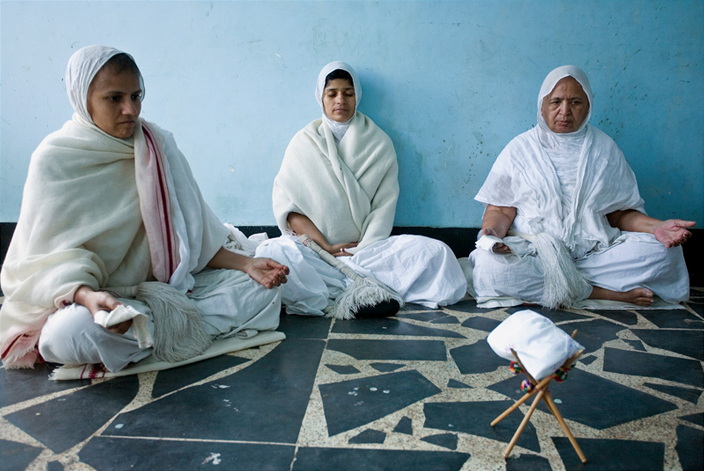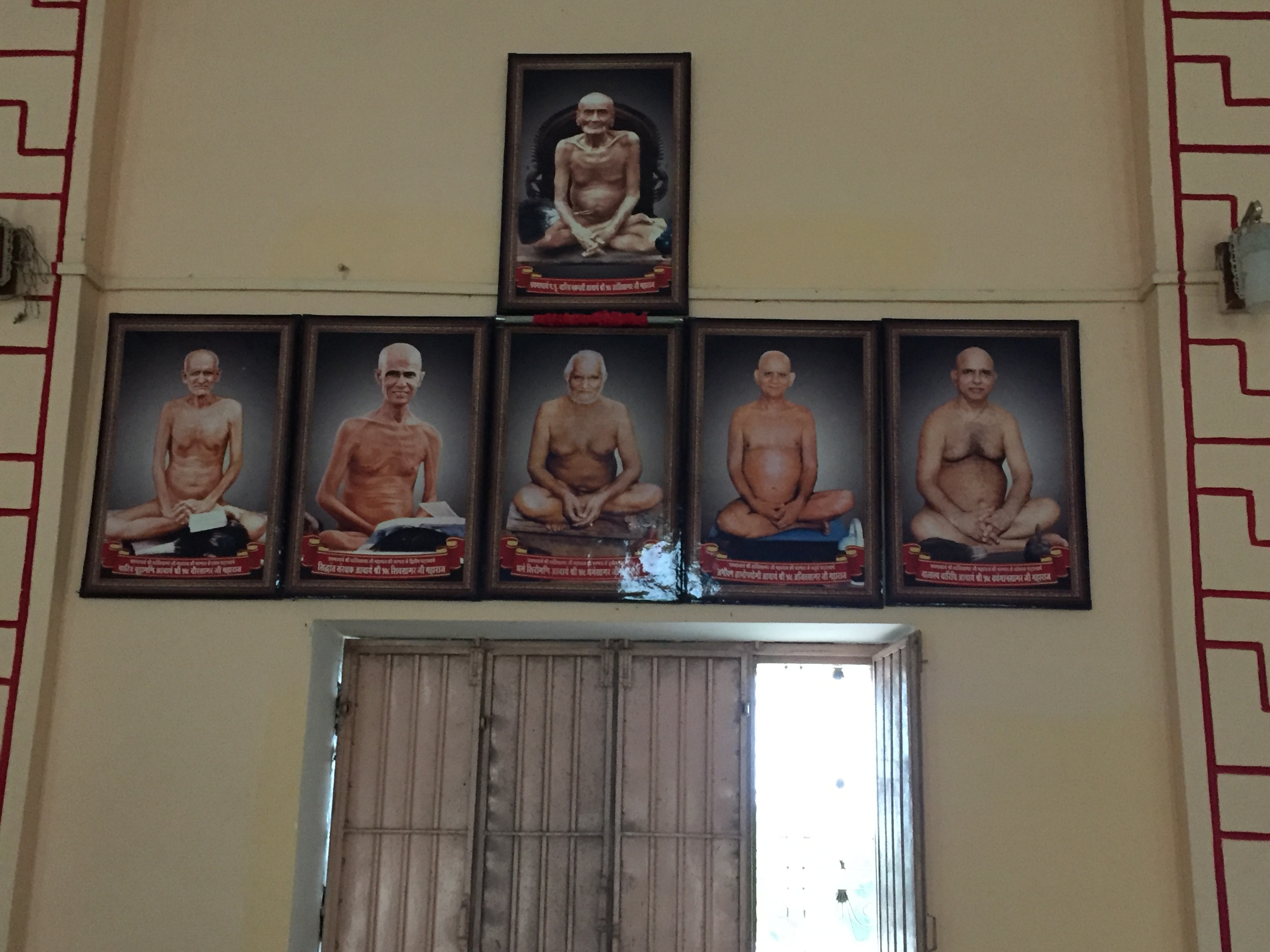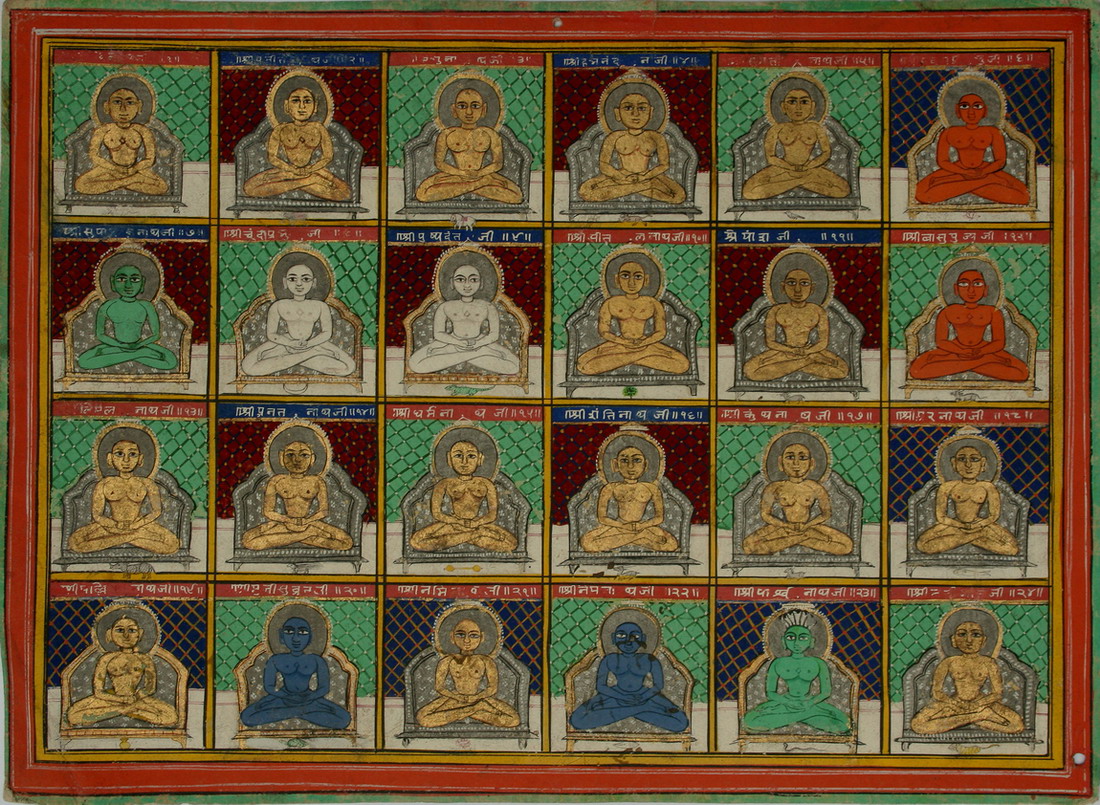|
Acharya (Jainism)
An ''Āchārya'' () is the leader of an order of Jain ascetics (Munis), termed a sangh in the Jain tradition. Some of the famous achāryas are Bhadrabahu, Sthulibhadra, Kundakunda, Samantabhadra (Jain monk), Samantabhadra, Umaswati, Acharya Haribhadrasuri, Haribhadra, Hemachandra. In the Namokar Mantra, the five panch-paramsthis include Acharyas, Upadhyayas and the ordinary Munis(Sadhus). The lineage (line of ordination) of Āchāryas goes back to Lord Mahavira Swami. After the Ganadharas (immediate disciples of Lord Mahavira), there was a lineage of Kevalis (ending with Jambuswami), who were succeeded by Shrutakevalin, Shruta-Kevalis. After the last Shruta-Kevali Bhadrabahu, two separate lineages of Acharyas emerged, a Digambar lineage and a Shvetambara lineage. Several lineages of the Acharyas exist in both sects. The lineages became Bhattaraka or Yati lineages when it became impossible for them to travel freely. Reforms during the British period restored the Acharya linea ... [...More Info...] [...Related Items...] OR: [Wikipedia] [Google] [Baidu] |
Tapas (Indian Religions)
Tapas (Sanskrit: तपस्, romanized: tapas) is a variety of austere spiritual meditation practices in Indian religions. In Jainism, it means asceticism (austerities, body mortification); in Buddhism, it denotes spiritual practices including meditation and self-discipline; and in the different traditions within Hinduism it means a spectrum of practices ranging from asceticism, 'inner cleansing' to self-discipline by meditation practices. The ''Tapas'' practice often involves solitude and is a part of monastic practices that are believed to be a means to moksha (liberation, salvation). In the Vedas literature of Hinduism, fusion words based on ''tapas'' are widely used to expound several spiritual concepts that develop through heat or inner energy, such as meditation, any process to reach special observations and insights, the spiritual ecstasy of a yogin or ''Tāpasa'' (a vṛddhi derivative meaning "a practitioner of austerities, an ascetic"), even warmth of sexual inti ... [...More Info...] [...Related Items...] OR: [Wikipedia] [Google] [Baidu] |
Shantisagar
Acharya Shri Shantisagar Ji (1872–1955) was an Indian Acharya of the Digambara monk faith. He was the first Acharya (Jainism), Acharya (preceptor) and a leader of his digamber sect in the 20th century. Shanti Sagar ji revived the teaching and practice of traditional Digambara practices in North India. He was lustrated as a kshullaka into the Sangha (holy order) by Devappa (Devakirti) Swami Ji. He took his ailaka deeksha (religious vows) before an image of the Tirthankara Neminatha. In about 1920, Shantisagar Ji became a Digambara muni (sadhu). In 1922, at Yarnal village, Belgaum district, Karnataka, he was given the name "Shanti Sagar Ji". Early life Shantisagar ji was born in 1872 near Bhoj village in what is now Belagavi district, Belgavi district in Karnataka, India. His father either worked as a farmer or was employed in the clothing business. At age eighteen, having read religious texts and undergone several pilgrimages, Shantisagar Ji decided to dedicate his life to a ... [...More Info...] [...Related Items...] OR: [Wikipedia] [Google] [Baidu] |
Digambara Monk
A Digambara monk or Digambara Sādhu (also ''muni'', ''sādhu'') is a Sādhu in the Digambar tradition of Jainism, and as such an occupant of the highest limb of the four-fold ''sangha''. Digambar Sādhus have 28 primary attributes which includes observance of the five supreme vows of ''ahimsa'' (non-injury), truth, non-thieving, celibacy and non-possession. A Digambar Sādhu is allowed to keep only a feather whisk, a water gourd and scripture with him. In Jainism, those '' śrāvakas'' (householders) who wish to attain ''moksha'' (liberation) renounce all possessions and become an ascetic. According to the Jain text, '' Dravyasamgraha'': Digambar Sādhus are also called ''nirgranth'' which means "one without any bonds". The term originally applied to those of them who were on the point of attaining omniscience, on the attainment of which they were called ''munis''. Rishabhanath (the first '' Tirthankar'') is said to be the first ''Digambar'' Sādhu of the present hal ... [...More Info...] [...Related Items...] OR: [Wikipedia] [Google] [Baidu] |
Pañca-Parameṣṭhi
The () in Jainism is a fivefold hierarchy of religious authorities worthy of veneration. Overview The five supreme beings are: #'' Arihant'': The awakened souls who have attained kevala jnana are considered as Arihants. The 24 tirthankaras or Jinas, the legendary founding figures of Jainism in the present time cycle, are Arihants. All tirthankaras are Arihants, but not all Arihants are tirthankaras. #''Siddha'' (Ashiri): The souls which have been liberated from the birth and death cycle. #'' Acarya'' #''Upadhyaya'' ("Preceptors") #''Muni'' or '' Jain monks'' The five initials, viz. ''A+A+A+U+M'' are taken as forming the Aum syllable. Five supreme beings The more ancient canonical texts of the Śvetāmbara sect mention ''Pañca-Parameṣṭhi'' (five supreme beings) to be the venerable beings in the universe. The Dravyasaṃgraha, a Digambara text, succinctly characterizes the five Supreme Beings (''Pañca-Parameṣṭhi''). #Definition of the World Teacher (Arhat) ... [...More Info...] [...Related Items...] OR: [Wikipedia] [Google] [Baidu] |
Tirthankara
In Jainism, a ''Tirthankara'' (; ) is a saviour and supreme preacher of the ''Dharma (Jainism), dharma'' (righteous path). The word ''tirthankara'' signifies the founder of a ''Tirtha (Jainism), tirtha'', a fordable passage across ''Saṃsāra (Jainism), saṃsāra'', the sea of interminable birth and death. According to Jains, ''tirthankaras'' are the supreme preachers of ''dharma'', who have conquered ''saṃsāra'' on their own and made a path for others to follow. After understanding the true nature of the self or soul, the ''Tīrthaṅkara'' attains ''kevala jnana'' (omniscience). A Tirthankara provides a bridge for others to follow them from ''saṃsāra'' to ''moksha'' (liberation). In Jain cosmology, the wheel of time is divided into two halves, Utsarpiṇī', the ascending time cycle, and ''avasarpiṇī'', the descending time cycle (said to be current now). In each half of the cycle, exactly 24 ''tirthankaras'' grace this part of the universe. There have been infini ... [...More Info...] [...Related Items...] OR: [Wikipedia] [Google] [Baidu] |
Sāmāyika
''Sāmāyika'' is the vow of periodic concentration observed by the Jains. It is one of the essential duties prescribed for both the ''Śrāvaka'' (householders) and ascetics. The preposition ''sam'' means one state of being. To become one is ''samaya''. That, which has oneness as its object, is ''sāmāyikam''. ''Sāmāyika'' is aimed at developing equanimity and to refrain from injury. On the third '' pratimā'' (stage) the householder resolves to observe the ''sāmāyika'' vow three times a day. According to the Jain text, '' Purushartha Siddhyupaya'': ''Sāmāyika'' is also one of the five kinds of conduct (''cāritra'') other kinds being reinitiation, purity of non-injury, slight passion and perfect conduct. It is of two kinds — with and without time limit. Duration The ''sāmāyika'' is performed for an ''antara-muhurta'' (about 48 minutes) every day. Champat Rai Jain in his book ''The Key of Knowledge'' writes: Procedure In performing ''sāmāyika'', the ''� ... [...More Info...] [...Related Items...] OR: [Wikipedia] [Google] [Baidu] |
Arihant (Jainism)
''Arihant'' (, ) is a jiva (soul) who has conquered inner passions such as attachment, anger, pride and greed. Having destroyed four inimical karmas, they realize pure self. ''Arihants'' are also called ''kevalins'' ( omniscient beings) as they possess '' kevala jnana'' (pure infinite knowledge). An ''arihant'' is also called a ''jina'' ("victor"). At the end of their life, ''arihants'' destroy remaining '' karmas'' and attain ''moksha'' (liberation) and become '' siddhas''. ''Arihantas'' have a body while ''siddhas'' are bodiless pure spirit. The Ṇamōkāra mantra, the fundamental prayer dedicated to '' Pañca-Parameṣṭhi'' (five supreme beings), begins with ''Ṇamō arihantāṇaṁ'', "obeisance to the arihants". ''Kevalins'' - omniscient beings - are said to be of two kinds # ''Tirthankara kevalī'': 24 human spiritual guides who after attaining omniscience teach the path to salvation. # ''Sāmānya kevalī'': ''Kevalins'' who are concerned with their own liber ... [...More Info...] [...Related Items...] OR: [Wikipedia] [Google] [Baidu] |
Tattva (Jainism)
Jain philosophy explains that nine (Śvetāmbara tradition) or seven (Digambara tradition) ''tattva'' (truths or fundamental principles) constitute reality. These are: #''jīva (Jainism), jīva'' – the soul which is characterized by consciousness #''ajiva, ajīva'' – the non-soul #''puṇya'' (alms-deed) – which purifies the soul and provide happiness to others #''pāpa'' (sinful acts) – which impurifies the soul #''āsrava'' (influx) – inflow of auspicious and evil karmic matter into the soul. #''bandha (Jainism), bandha'' (bondage) – mutual intermingling of the soul and ''karmas''. #''samvara, saṃvara'' (stoppage) – obstruction of the inflow of karmic matter into the soul. #''nirjara, nirjarā'' (gradual dissociation) – separation or falling-off of parts of karmic matter from the soul. #''moksha (Jainism), mokṣa'' (liberation) – complete annihilation of all karmic matter (bound with any particular soul). The knowledge of these realities is said to be ... [...More Info...] [...Related Items...] OR: [Wikipedia] [Google] [Baidu] |
Dravya (Jainism)
''Dravya'' () means substance or entity. According to the Jain philosophy, the universe is made up of six eternal substances: sentient beings or souls ('' jīva''), non-sentient substance or matter (''pudgala''), principle of motion (''dharma''), the principle of rest ('' adharma''), space ('' ākāśa'') and time (''kāla'').Grimes, John (1996). Pp.118–119 The latter five are united as the ''ajiva'' (the non-living). As per the Sanskrit etymology, ''dravya'' means substances or entity, but it may also mean real or fundamental categories. Jain philosophers distinguish a substance from a body, or thing, by declaring the former as a simple element or reality while the latter as a compound of one or more substances or atoms. They claim that there can be a partial or total destruction of a body or thing, but no ''dravya'' can ever be destroyed. The Vaisheshika school of Indian philosophy also deals with a concept of ''dravya''. Classification and importance in Jainism The ''dra ... [...More Info...] [...Related Items...] OR: [Wikipedia] [Google] [Baidu] |
Pujyapada
Acharya Pujyapada or Pūjyapāda (464–524 CE) was a renowned grammarian and ''Acharya (Jainism), acharya'' (philosopher monk) belonging to the Digambara tradition of Jainism, Jains. It was believed that he was worshiped by demigods on the account of his vast scholarship and deep piety, and thus, he was named Pujyapada. He was said to be the guru of King Durvinita of the Western Ganga dynasty. Life Pujyapada is said to have lived from 510 CE to 600 CE. Born under the name Devanandi to parents Madhava Bhatta and Shridevi, he was a sadhu Digambara monk, as well as a yogi, mystic, poet, scholar, author and master of several branches of learning. As the Devs from heaven used to come to do Puja (Hinduism), Puja of his feet Paad, the title of Pujyapaad was given to him. He was heavily influenced by the writings of his predecessors like ''Acharya'' Kundakunda and ''Acharya'' Samantabhadra (Jain monk), Samantabhadra. He is rated as being the greatest of the early masters of Jain lite ... [...More Info...] [...Related Items...] OR: [Wikipedia] [Google] [Baidu] |
Acharya Chandana
Acharya Chandana (born Shakuntala in 1937), known as Tai Maharaj by her devotees, is an Indian Jain nun of the Amarmuni Sampradaya. Chandana is the first Jain sadhvi (female renunciant) to be awarded the title of Acharya and the Padma Shri. Chandana is known for her social engagement and for popularising the notion of 'seva' (human service) among the Jain community. She is the founder of Veerayatan, a non-profit, non-governmental organization based in Rajgir with centers in over ten countries. Early life On 26 January 1937, Chandana was born as Shakuntala, in the Kataria family in the village of Chaskaman in the Pune district of Maharashtra. Her mother was Premkunwar Katariya, and her father was Manikchand Katariya. She received formal education until the third grade. From childhood, she longed to aid and serve those in need. Monastic life Shakuntala's maternal grandfather persuaded her to be initiated as a sadhvi by Sumati Kunvar. At the age of fourteen, she received J ... [...More Info...] [...Related Items...] OR: [Wikipedia] [Google] [Baidu] |
Dravyasamgraha
' (Devnagari: द्रव्यसंग्रह) (Compendium of substances) is a 10th-century Jain text in Jain Sauraseni Prakrit by Acharya Nemicandra belonging to the Digambara Jain tradition. It is a composition of 58 ''gathas'' (verses) giving an exposition of the six '' dravyas'' (substances) that characterize the Jain view of the world: sentient ''( jīva)'', non-sentient ''(pudgala)'', principle of motion ''(dharma)'', principle of rest ''(adharma)'', space ''(ākāśa)'' and time ''(kāla)''.Acarya Nemicandra; Nalini Balbir (2010) p. 1 of Introduction It is one of the most important Jain works and has gained widespread popularity. ' has played an important role in Jain education and is often memorized because of its comprehensiveness as well as brevity. Author 10th century Jain Acarya, Nemicandra Siddhānta Cakravartin is regarded as the author of '. He was the teacher of Camundaraya—the general of the Western Ganga Dynasty of Karnataka. Nemicandra was a pr ... [...More Info...] [...Related Items...] OR: [Wikipedia] [Google] [Baidu] |








